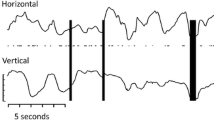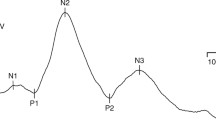Abstract
Five children with a history of preterm birth (mean gestational age of 27 weeks; birth weight 870–1,380 g) and perinatal post-hemorrhagic hydrocephalus were examined ophthalmologically at ages ranging from 4–11 years. An extended visual evoked potentials (VEPs) examination was simultaneously performed, using pattern-reversal, motion-onset, and cognitive visual stimuli. Although 3 of the 10 eyes displayed about normal visual acuity (≥0.9), all of the examined eyes were abnormal for at least one variant of the tested VEPs. Pathological changes in VEPs (missing responses, shape abnormalities due to delayed VEPs maturation, prolonged peak latencies, and reduced amplitudes) were roughly proportional to both gestational age and reduction in visual acuity. A more severe pathology was found in the motion-onset VEPs (in all five subjects - nine eyes) when compared to the pattern-reversal VEPs (in four subjects - eight eyes). These observations suggest that the magnocellular system/dorsal stream of the visual pathway (which is particularly activated in response to motion stimuli) may be more frequently affected in preterm children than the parvocellular system/ventral stream (tested mostly by the standard pattern-reversal VEPs). This pilot study may encourage further testing of the combined pattern and motion-related VEPs examinations in preterm children as a way of detecting hidden cortical/cerebral visual impairment (CVI).

Similar content being viewed by others
Abbreviations
- CNS:
-
Central nervous system
- CVI:
-
Cortical/cerebral visual impairment
- VEPs:
-
Visual evoked potentials
References
Good WV, Jan JE, Burden SK, Skoczenski A, Candy R (2001) Recent advances in cortical visual impairment. Dev Med Child Neurol 43:56–60
Peychl I (2005) Preterm child in pediatric care (in Czech). Galén, Prague (ISBN 80-7262-283-8)
Volpe JJ (2001) Neurology of the newborn (4th edn.) W.B. Saunders Company, Philadelphia
Caravale B, Tozzi C, Albino G, Vicari S (2005) Cognitive development in low risk preterm infants at 3–4 years of life. Arch Dis Child Fetal Neonatal Ed 90:F474–F479
Porro G, Dekker EM, Van Nieuwenhuizen O, Schilder MBH, Wittebol-Post D, Schenk-Rootlieb AJF et al (1998) Visual behaviours of neurologically impaired children with cerebral visual impairment: an ethological study. Br J Ophthalmol 82:1231–1235
Philips J, Stehen P, Christiansen P, Ware G, Landers S, Russel SK (1997) Ocular morbidity in very low birth-weight infants with intraventricular hemorrhage. Am J Ophthalmol 123:218–223
Dutton GN, Saaed A, Fahad B, Fraser R, McDaid G, McDade J et al (2004) The association of binocular lower visual field impairment, impaired simultaneous perception, disordered visually guided motion and inaccurate saccades in children with cerebral visual dysfunction–a retrospective observational study. Eye 18:27–34
Christiansen SP, Fray KJ, Spencer T (2002) Ocular outcomes in low birth weight premature infants with intraventricular hemorrhage. J Pediatr Ophthalmol Strabismus 39:157–165
Moore AT (1999) Brain injury and ocular motor abnormalities in surviving preterm infants. Br J Ophthalmol 83:509–511
Jan JE, Good WV, Hoyt CS (2004) An international classification of neurological visual disorders in children. American Printing House for the Blind, Inc. http://www.aph.org/cvi/articles/jan_1.html Cited 21 Sept 2007
Good WV, Jan JE, deSa I, Barkovich A, Groenveld M, Hoyt CS. (1994) Cortical visual impairment in children: a major review. Survey Ophthal 88: 351–64
Baker-Nobles L, Rutherford A (1995) Understanding cortical visual impairment in children. Am J Occup Therapy 49: 899–903
Kuba M, Kubová Z, Kremláček J, Langrová J (2007) Motion-onset VEPs: characteristics, methods, and diagnostic use. Vision Res 47:189–202
Heinrich SP (2007) A primer on motion visual evoked potentials. Doc Ophthalmol 114:83–105
Langrová J, Kuba M, Kremláček, Kubová Z, Vít F (2006) Motion-onset VEPs reflect long maturation and early aging of visual motion-processing system. Vision Res 46:536–544
McKee S, Nakayama K (1984) The detection of motion in the peripheral visual field. Vision Res 24:25–33
Orban GA, Kennedy H, Bullier J (1986) Velocity sensitivity and direction selectivity of neurons in areas V1 and V2 of the monkey: influence of eccentricity. J Neurophysiol 56:462–480
Kaplan E, Shapley RM (1986) The primate retina contains two types of ganglion cells, with high and low contrast sensitivity. Proc Nat Ac Sci USA 83:2755–2757
Kuba M, Kubová Z (1992) Visual evoked potentials specific for motion-onset. Doc Ophthalmol 80:80–89
Bach M, Ullrich D (1994) Motion adaptation governs the shape of motion-evoked cortical potentials (motion VEP). Vis Res 34:1541–1547
Kremláček J, Kuba M, Kubová Z, Chlubnová J (2004) Motion-onset VEPs to translating, radial, rotating and spiral stimuli. Doc Ophthalmol 109:169–175
Kubová Z, Kuba M, Hubáček J, Vít F (1990) Properties of visual evoked potentials to onset of movement on a television screen. Doc Ophthalmol 75:67–72
Jacobson L, Hård A-L, Svensson E, Flodmark O, Hellström A (2003) Optic disc morphology may reveal timing of insult in children with periventricular leucomalacia and/or periventricular haemorrhage. Br J Ophthalmol 87:1345–1349
Morrone MC, Tosetti M, Montanaro D, Fiorentini A, Cioni G, Burr DC (2000) A cortical area that responds specifically to optic flow, revealed by fMRI. Nat Neurosci 3:1322–1328
Ptito M, Kupers R, Faubert J, Gjedde A (2001) Cortical representation of inward and outward radial motion in man. Neuroimage 14:1409–1415
Pike MG, Holmström G, de Vries LS, Pennock JM, Drew KJ et al (1994) Patterns of visual impairment associated with lesions of the preterm infant brain. Develop Med Child Neurol 36:849–862
Signorini SG, Bova SM, La Piana R, Bianchi PE, Fazzi E (2005) Neurobehavioral adaptations in cerebral visual impairment. Int Congress Ser 1282:724–728
Spierer A, Royzman Z, Kuint J (2004) Visual acuity in premature infants. Ophthalmologica 218:397–401
Saunders KJ, McCulloch DL, Shepherd AJ, Wilkinson AG (2002) Emmetropisation following preterm birth. Br J Ophthalmol 86:1035–1040
Jacobson L, Ygge J, Flodmark O (2002) Visual and perceptual characteristics, ocular motility and strabismus in children with periventricular leukomalacia. Strabismus 10:179–183
Desch LW (2001) Longitudinal stability of visual evoked potentials in children and adolescents with hydrocephalus. Devel Med Child Neurol 43:113–117
Dutton GN (2004) Congenital disorders of the optic nerve: excavations and hypoplasia. Eye 18:1038–1048
Huo R, Burden S, Hoyt C, Good WV (1999). Chronic visual impairment in children: etiology, prognosis, and associated neurological deficits. Br J Ophthalmol 83:670–675
Lowery RS, Atkinson D, Lambert SR (2006) Cryptic cerebral visual impairment in children. Br J Ophthalmol 90:960–963
Hoyt CS, Fredrick DR (1998) Cortically visually impaired children: a need for more study. Br J Ophthalmol 82:1225–1227
Lim M, Soul JS, Hansen RM, Mayer DL (2005) Development of visual acuity in children with cerebral visual impairment. Arch Ophthalmol 123:1215–1220
Good WV (2001) Development of a quantitative method to measure vision in children with chronic cortical visual impairment. Tr Am Ophth Soc 99:253–269
Kubová Z, Kuba M (1992) Clinical application of motion-onset visual evoked potentials. Doc Ophthalmol 81:209–218
Inder TE, Huppi PS, Warfield S, Kikinis R, Zientara GP, Barnes PD et al (1999) Periventricular white matter injury in the premature infant is followed by reduced cerebral cortical gray matter volume at term. Ann Neurol 46:755–760
Fazzi E, Bova SM, Uggetti C, Signorini SG, Bianchi PE, Maraucci I et al (2004) Visual-perceptual impairment in children with periventricular leukomalacia. Brain Dev 26:506–512
Kubová Z, Szanyi J, Langrová J, Kremláček J, Kuba M, Honegr K (2006) Motion-onset and pattern-reversal visual evoked potentials in diagnostics of neuroborreliosis. J Clin Neurophysiol 23:416–420
Bastien CH, Boucher O, Saint-Amour D, Roy M-S, Dewailly É, Ayotte P et al (2007) Fetal PCB and MEHG exposure: Effects on visual P300 in 5-year-old Inuit children. Paper presented at the Internat. conference on fetal programming and developmental toxicity, Torshavn, Faroe Islands, 20–24 May 2007, http://www.pptox.dk/portals/0/52_poster.pdf. Cited on 21 Sept 2007
Acknowledgments
Supported by Ministry of Education of the Czech Republic (VZ 0021620816), by Grant Agency of Ministry of Health of the Czech Republic (No. NR 8421-4/2005) and by Grant Agency of Charles University 7360/2007/C.
Author information
Authors and Affiliations
Corresponding author
Rights and permissions
About this article
Cite this article
Kuba, M., Liláková, D., Hejcmanová, D. et al. Ophthalmological examination and VEPs in preterm children with perinatal CNS involvement. Doc Ophthalmol 117, 137–145 (2008). https://doi.org/10.1007/s10633-008-9115-z
Received:
Accepted:
Published:
Issue Date:
DOI: https://doi.org/10.1007/s10633-008-9115-z




